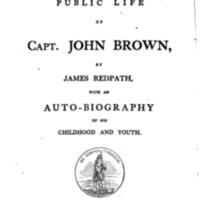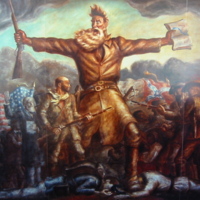Santa Fe Trail (1940)
Santa Fe Trail (1940) tells the story of J.E.B. Stuart (portrayed by Erroll Flynn) and George Custer (Ronald Reagan) stationed at Fort Leavenworth in Kansas, on the eve of “Bleeding Kansas.” John Brown is portrayed as a villain and a madman, and Custer and Stuart work together—despite their differing views on the sectional conflict on the eve of the Civil War—to fight against him. Director Michael Curtiz and writer Robert Buckner, created a highly fictionalized account of what happened in Kansas at the time in order to tell a story of unity between the North and South even as the Civil War was approaching. Santa Fe Trail came out as World War II raged in Europe and a year before the United States’ involvement. The film may have served as propaganda for the U.S. entry in WWII, representing a nation coming together despite political differences to fight a greater evil.[1]
Santa Fe Trail is one of several films that came out between 1915 and 1940 that depicts reconciliation between the North and the South. It presents most northerners and southerners as patriotic Americans and places blame for the Civil War on fanatical abolitionists. It prompted critiques from the National Association for the Advancement of Colored People (NAACP), and several members of John Brown’s descendants sued Warner Brothers for the depiction of their ancestor.[2]
The entire movie is available on the Internet Archive.
[1] Larry J. Easley, “The Santa Fe Trail: John Brown and the Coming of the Civil War,” Film & History 13, no. 2 (May 1983): 25–33; Peter S. Carmichael, “The Classics: Hollywood Turns History on Its Head in Santa Fe Trail,” Civil War Times 42, no. 5 (December 2003): 92; for a contrasting interpretation of the movie, see Peggy A. Russo, “John Brown Goes to Hollywood: Santa Fe Trail and Seven Angry Men,” in Terrible Swift Sword: The Legacy of John Brown, ed. Paul Finkelman and Peggy A. Russo (Athens: Ohio University Press, 2005), 190–212. For contrasting scholarly interpretations of John Brown, see John William Burgess, Civil War and the Constitution, 1859-1865 (New York: Scribner, 1901); David S. Reynolds, John Brown, Abolitionist: The Man Who Killed Slavery, Sparked the Civil War, and Seeded Civil Rights (New York: Alfred A. Knopf, 2005).
[2] Alice Keesey Mecoy, “John Brown Kin: Brown Descendant Sues Over Santa Fe Trail Movie,” John Brown Kin, January 16, 2010, accessed August 16, 2016, http://johnbrownkin.blogspot.com/2010/01/brown-descendant-sues-over-santa-fe.html.
Primary Sources
Secondary Sources
Burgess, John William. Civil War and the Constitution, 1859-1865. New York: Scribner, 1901.
Carmichael, Peter S. “The Classics: Hollywood Turns History on Its Head in Santa Fe Trail.” Civil War Times 42, no. 5 (December 2003): 92.
Easley, Larry J. “The Santa Fe Trail: John Brown and the Coming of the Civil War.” Film & History 13, no. 2 (May 1983): 25–33.
Mecoy, Alice Keesey. “John Brown Kin: Brown Descendant Sues Over Santa Fe Trail Movie.” John Brown Kin, January 16, 2010. http://johnbrownkin.blogspot.com/2010/01/brown-descendant-sues-over-santa-fe.html.
Reynolds, David S. John Brown, Abolitionist: The Man Who Killed Slavery, Sparked the Civil War, and Seeded Civil Rights. New York: Alfred A. Knopf, 2005.
Russo, Peggy A. “John Brown Goes to Hollywood: Santa Fe Trail and Seven Angry Men.” In Terrible Swift Sword: The Legacy of John Brown, edited by Paul Finkelman and Peggy A. Russo, 190–212. Athens: Ohio University Press, 2005.


